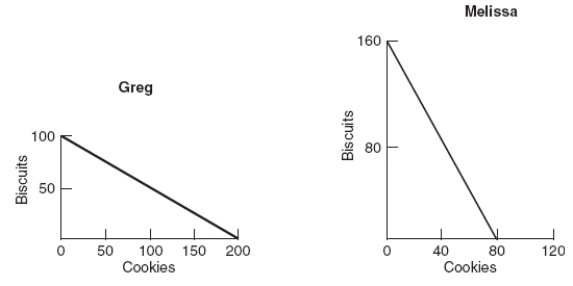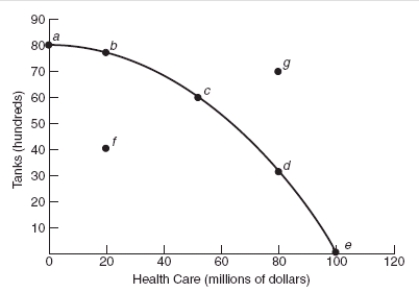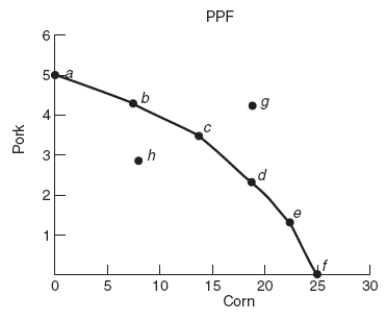A) a sewing machine
B) an apprentice
C) mineral deposits
D) a copier
Correct Answer

verified
Correct Answer
verified
Multiple Choice
A country operating inside of its production possibilities frontier (PPF) is operating:
A) efficiently.
B) inefficiently and at an unattainable level.
C) inefficiently but in an area that can be attained.
D) in the unattainable region.
Correct Answer

verified
Correct Answer
verified
Multiple Choice
To answer the question of how goods and services are to be produced, society must decide:
A) what products businesses want to produce.
B) how to combine its scarce resources to produce the desired products.
C) what products the government wants.
D) what products to export.
Correct Answer

verified
Correct Answer
verified
Multiple Choice
The two basic determinants of economic growth are _____ and _____.
A) expanding resources; improving technologies
B) tariffs; trading with weaker countries
C) income taxes; human capital
D) government spending; labor productivity
Correct Answer

verified
Correct Answer
verified
Multiple Choice
Capital, which includes all manufactured products that are used to produce other goods and services, earns:
A) profit.
B) wages.
C) interest.
D) rent.
Correct Answer

verified
Correct Answer
verified
Multiple Choice
(Figure: Biscuits and Cookies PPFs) Looking at Greg and Melissa's production possibilities frontiers (PPFs) , what production and trade situation would allow both Greg and Melissa to consume a combination of biscuits and cookies outside their PPF? 
A) Greg produces 200 cookies, Melissa produces 160 biscuits, and Greg trades 100 cookies in exchange for 30 biscuits.
B) Greg produces 200 cookies, Melissa produces 160 biscuits, and Greg trades 100 cookies in exchange for 60 biscuits.
C) Greg produces 100 biscuits, Melissa produces 80 cookies, and Greg trades 50 biscuits in exchange for 40 cookies.
D) Greg produces 100 biscuits, Melissa produces 80 cookies, and Greg trades 50 biscuits in exchange for 70 cookies.
Correct Answer

verified
Correct Answer
verified
Multiple Choice
(Figure: Tanks and Health Care) Which point in the figure is obtainable but NOT efficient? 
A) point a
B) point b
C) point f
D) point g
Correct Answer

verified
Correct Answer
verified
Multiple Choice
The key benefit of countries engaging in trade based on comparative advantage is that:
A) both countries will be able to consume more than they would with no trade.
B) it allows countries to produce efficiently inside of their individual production possibilities frontiers.
C) it allows both countries to maximize their opportunity cost.
D) None of these is a key benefit.
Correct Answer

verified
Correct Answer
verified
Multiple Choice
The Scandinavian countries of Europe:
A) have economies coordinate solely by markets.
B) allow a large role for government services.
C) have no barriers to the market.
D) do not protect property rights.
Correct Answer

verified
Correct Answer
verified
Multiple Choice
A country can use its given resources to produce capital goods or consumer goods. This implies that:
A) an economy can "have it all."
B) there is a conflict between capitalists and consumers.
C) more consumption in the present leads to higher economic growth for future generations.
D) there is a tradeoff between the current and the future standard of living.
Correct Answer

verified
Correct Answer
verified
Multiple Choice
The derivation of a production possibilities frontier assumes that:
A) some resources are not being used.
B) there is a fixed quantity of resources and technology available.
C) some resources are not being produced efficiently.
D) technology is free.
Correct Answer

verified
Correct Answer
verified
True/False
Natural resources, such as water, are included in capital resources.
Correct Answer

verified
Correct Answer
verified
Multiple Choice
When a society is producing the mix of goods that the society wants to consume, then it is said to have:
A) solved the economic problem.
B) an equitable distribution of goods and services.
C) an efficient form of government.
D) obtained allocative efficiency.
Correct Answer

verified
Correct Answer
verified
True/False
(Figure: Pork and Corn PPF) It is possible to produce 15 units of corn and 4 units of pork at the same time. 
Correct Answer

verified
Correct Answer
verified
Multiple Choice
The conversion of resources to satisfy wants is described as:
A) consumption.
B) distribution.
C) production.
D) conservation.
Correct Answer

verified
Correct Answer
verified
True/False
Natural resources in the production process are called land and their payment is called interest.
Correct Answer

verified
Correct Answer
verified
True/False
Capital, as a factor of production, includes all manufactured products that are used to produce other goods.
Correct Answer

verified
Correct Answer
verified
Multiple Choice
If the government of Spain decides to spend less on the military and more on health care, the forgone spending on military items represents the:
A) cost factor of the extra health care.
B) production efficiency of the extra health care.
C) opportunity cost of the extra health care.
D) allocative cost of the extra health care.
Correct Answer

verified
Correct Answer
verified
True/False
The "what" question of the three basic questions is "What price should be charged for a good?"
Correct Answer

verified
Correct Answer
verified
Multiple Choice
Which of the following shifts the production possibilities frontier outward?
A) a decreasing population
B) capital accumulation
C) increasing prices
D) increasing consumption
Correct Answer

verified
Correct Answer
verified
Showing 121 - 140 of 342
Related Exams